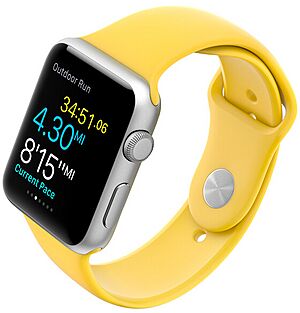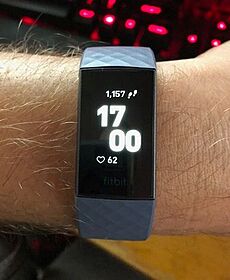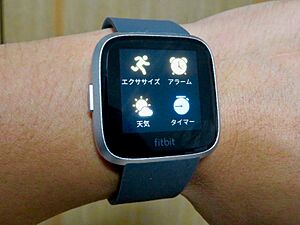Fitness tracker facts for kids
A fitness tracker or activity tracker is a cool electronic device or app. It helps you measure and collect information about your body's movements and how you respond physically. This helps you keep an eye on and improve your health, fitness, or even your mood over time.
Fitness trackers are like super smart pedometers. Besides counting your steps, they have extra sensors. These sensors, like accelerometers and altimeters, can gather or guess information. This includes how fast you move, how far you travel, your heart rate, how many calories you use, and even how long and how well you sleep.
Thanks to big improvements in computer technology, especially with smartphones, these wearable trackers became very popular. They have built-in sensors that collect lots of information. This data is then sent to apps on your phone. This can include details about your fitness, mood, sleep, and how much water you drink. Because so much information is collected, some people worry about how companies store and use this data.
Contents
How Fitness Trackers Started
Wearable heart rate monitors for athletes first appeared in 1981. As technology got better, it became easier to record fitness activities automatically. These monitors could also be built into gear that was simple to wear. For example, the RS-Computer shoe came out in 1986.
Early devices included bicycle computers that looked like wristwatches. They tracked speed, how long you rode, and distance. These were around by the early 1990s. By the early 2000s, you could buy wearable fitness trackers for everyday use. These included wireless heart rate monitors that could connect to exercise machines at the gym.
Later, fitness trackers became wristbands, armbands, or small clips. In 2006, Apple and Nike teamed up to release the Nike+iPod. This was a shoe with a sensor that worked with an iPod Nano.
Around 2010, many apps were created for logging your activities. Many of these let you share your data directly on social media like Facebook or Twitter. Fitness trackers became popular because they made exercise feel like a game. Sharing your progress with friends added a social side, and friendly competition made people more motivated.
In 2016, new fitness trackers were made especially for kids. Organizations like UNICEF and Garmin offered different options.
Different Kinds of Trackers
Most fitness trackers you see are worn on your wrist, like a wristwatch. These usually have a screen to show your data. But wrist trackers might not be super accurate during exercises where your arms move very fast.
Some fitness trackers are shaped like a ring. Ring trackers don't have their own screen. They connect to a smartphone to show you the information they collect.
Another small type of tracker has its sensors inside earphones. Like ring trackers, these also need a smartphone to show your data. Earphone-based trackers can take readings directly from tiny blood vessels inside your ear. Because of where they are placed, these trackers can give more accurate results for things like heart rate and body temperature.
Smartwatches That Track Activity

Many devices that are mainly smartwatches can also work as fitness trackers. The Apple Watch is an early example. It has offered fitness tracking features since 2014. Other brands like Fitbit and Garmin also make smartwatches that track your activity and health.
Tracker Apps and Your Data
The apps that come with fitness trackers usually show your data as statistics. You look at these numbers after you've finished your activity. But some research suggests that if we want to understand the data even better, the apps need to be smarter about how they show it to us.
Are Trackers Always Perfect?
Sometimes, how you move can make the results from fitness trackers a little off. For example, one test showed that some products couldn't accurately track a bike ride. Also, the numbers for how much energy your body used were sometimes wrong. For heart rate, wrist trackers can sometimes show big differences. For more accurate heart rate tracking, some people suggest using chest straps. Wristbands can also feel uncomfortable or even get lost.
Thinking About Your Privacy
There have been some questions about privacy when activity-tracking apps collect your information. Your health data can create a "digital health footprint." It's important to know that when you use these apps, your personal information is being collected.
Some fitness tracker apps might send your personal data, like your address book, to servers on the internet. They might do this without telling you or asking for your permission. Even if the data is made anonymous, just knowing where someone is located can sometimes be a concern. However, some studies show that certain users are happy to share their activity data on purpose.
In 2014, a company called Jawbone created a system called UP for Groups. This system could give employers general information from their employees' fitness trackers and apps.
How Trackers Can Affect Your Mind
Studies have looked at how health apps use "gamification." This is where you earn rewards for reaching your health goals. While this can make the app fun, some worry it might make health seem too simple. It could also distract users from their real health goals. There's also research that makes us think about how tracking devices change the way we see our bodies and our lives.
Wearable Sensors and Your Body
Wearable sensors are used a lot in health, sports, and safety. These sensors can spot unusual situations. They can also keep an eye on your body's functions and symptoms through these trackers. This technology has changed healthcare. It allows doctors to keep watching patients without them having to stay in the hospital. Trackers can deliver important information like body temperature, heart rate, brain activity, and muscle movement.
In sports training, wearable sensors are becoming more and more popular. For example, just a few years ago, you could only measure how much you sweat in a lab. Now, you can do it with wearable sensors. Heart rate variability (HRV) can help show how good an exercise plan is. It's also used by athletes as a warning sign if they are training too much. This way, HRV can help improve performance.
How Trackers Can Help with Health
Fitness trackers are not medical devices. But newer models are getting closer to being like medical monitors. Some companies hope to make them able to warn you about a health problem.
Spotting Irregular Heartbeats
Activity trackers have been used to help keep track of irregular heartbeats. These are heartbeats that are not steady or normal. Doctors often use special machines to record heartbeats. But they found that wearable wristbands can also be helpful for regular use. These wearables need to be accurate to avoid mistakes. One study found that the Apple Watch could detect and tell the wearer about an irregular pulse. Even though there's a small chance of a false alarm, the study showed it could be a useful first step to help people know if they need to see a doctor.
Helping with Healthy Habits
Fitness trackers have also been used to help people become more active and make healthier choices. For example, a Fitbit Alta wristband was used with teenagers to track their steps, distance, calories burned, activity time, and sleep. Researchers used this information to learn more about their habits. The study found that tracking steps and activity helped people become more aware of their lifestyle.
One review of several studies found that fitness trackers helped people increase their physical activity by about 1850 steps per day. Another study showed that using an activity monitor along with a guided healthy living program led to more improvements than either one alone.
Tracking Stress and Mood
Many apps are available that help with managing your mental well-being. Smartwatches can also help monitor stress and other mood changes. Studies have looked at different types of devices. These devices have sensors that can help detect stress, worry, and other feelings. Keeping an eye on these factors is important for understanding your overall well-being. For example, some wristbands can track activity, and a link was seen between heart rate levels and things like sleep patterns, stress, and age. It was found that tracking sleep, physical activity, mood changes, and social habits can help get more accurate measurements.
Watching Babies Grow
Wearable sensors have also been used to keep track of how babies develop. They can help monitor motor skills and physical growth.
Helping Caregivers
Other fitness trackers are made to watch important body signs in older people or those with certain health conditions. They can alert a caregiver if there's a problem.
For Our Animal Friends
Fitness trackers have even been designed for animals! For example, you can get collar-mounted fitness trackers for dogs.
See also
- Sleep tracking
- Actigraphy
- eHealth
- Internet of Things
- Quantified self, a movement to record, analyze, and improve one's daily life
- Smartwatch
- Wearable computer



